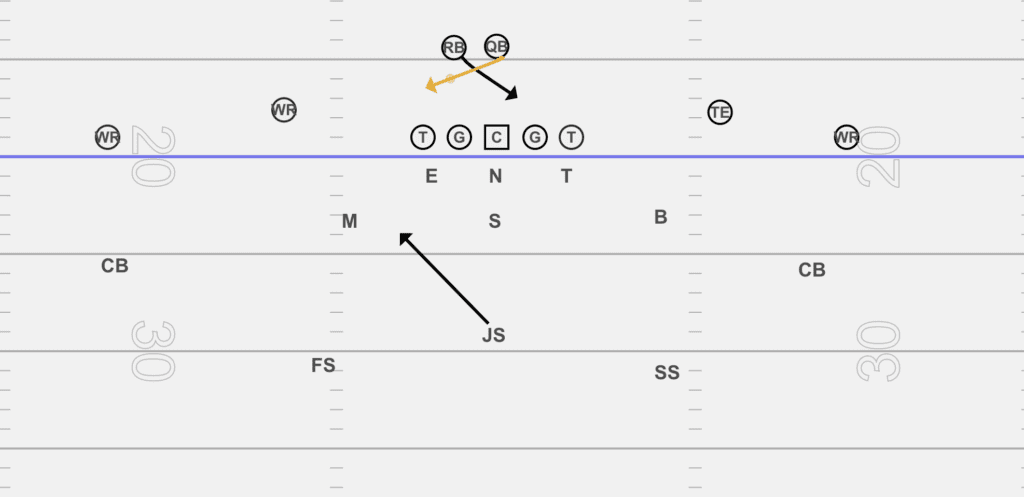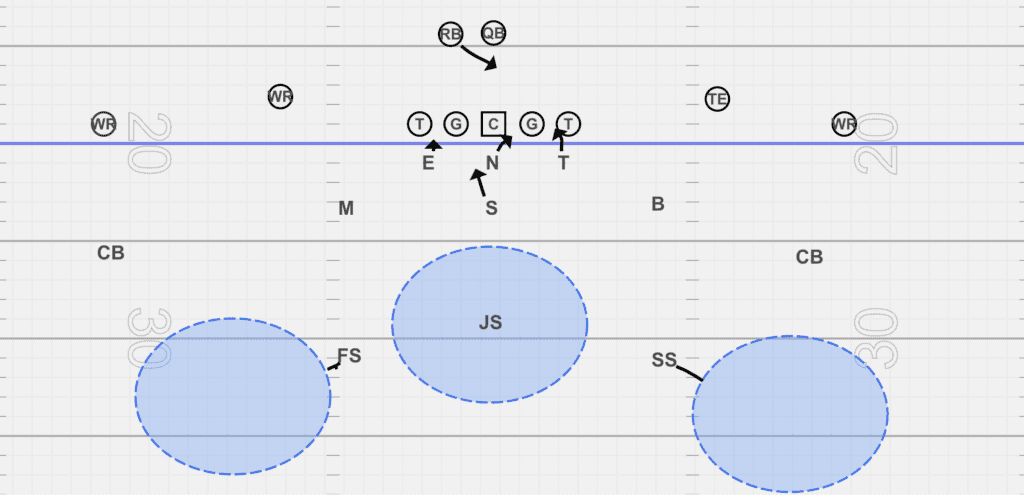The 3 high safety defense is slowly taking over football. Its rise in popularity over the years is mainly attributed to the Iowa State Cyclones. What is the 3 high safety defense, and why is it so popular?
The 3 high safety defense uses a safety in the middle of the field and 2 safeties on the hashes, similar to a cover 2 defense. The purpose of the 3 high safety defense is to be balanced against the run, pass, and RPO game.
In this article, we’re going to explain why the 3 high safety defense is popular and how teams are using it to stop high-powered offenses.
What Is The 3 High Safety Defense?
As the name states, the 3 high safety defense uses 3 safeties to do multiple tasks. While teams typically use 1 or 2 safeties (lined up at about >8 yards) to defend the run and pass, 3 high safety teams try to accomplish the same tasks but with faster players.
In any 3-4 or 3-5 structure, linebackers are a significant part of the defensive scheme. They are responsible for rushing the passer, stopping the run, and even covering receivers. While this was effective for a long period, the RPO was invented and started to put these bigger types of players in conflict.
The 3 high safety structure protects these conflict players and allows the middle safety to play downhill faster. It also allows teams to be multiple with coverage, including cover 2 and cover 3.
The middle safety acts as a linebacker on run plays but a safety on pass plays. The middle safety relies on their speed and ability to react quickly to make plays.
This is a great drawing from Cody Alexander of Match Quarters of how the 3 high safeties work together to stop by the run and pass.
As you can see, the middle safety (as labeled JS above) plays between a hybrid and a safety.
In the picture below, you can see how the Iowa State Cyclones use the 3 high safety shell against opponents.

The middle safety will typically line up 8-9 yards away from the line of scrimmage. This depth allows the middle safety to do multiple things.
Why Play The 3 High Safety Defense
Lining the middle safety at 8-9 yards allows them to be involved in any play. Let’s explain how 3 high safeties can be effective against the spread offense.
Defending The Zone Run
Almost all offensive schemes don’t take into account the safety position. They focus on the defensive line and the linebackers, and rightfully so. These are the players closest to the line of scrimmage and can make the most impact when the ball is snapped.
Offenses will use the zone run to put the defensive end in conflict, opening up a cut-back lane in the C gap.
However, teams that use the 3 high safety defense can use a “bend and chase” technique from their defensive end, forcing the quarterback to keep the ball. This means the middle safety can play the quarterback the entire way, often unblocked.
Learn How To Watch Film Properly…
Uncover your opponent’s offensive and defensive tendencies so you can easily build a game plan.
Inside You’ll Find:
- Strategies to pick apart defenses
- How to identify player weaknesses
- How to save time in your weekly breakdowns
Defending The RPO
College and high school football teams have to prepare for the 3rd element of offensive play, the RPO.
No longer can teams dedicate the front 7 to stopping the run and the back 4 to stopping the pass. Everyone needs to be on high alert.
This is why many coverages include getting the safety involved in the run fit.
It’s no different with the 3 high safety defenses. The middle safety can now attack the glance or hitch RPO. Simply by going to the same side of the back and reading the quarterback’s eyes, the middle safety can jump into the throwing lane of the RPO. This also allows them to carry into the path of the quarterback, keeping the ball on the zone run.
Protecting The Middle Of The Field
The OTB route (over the ball) has become one of the more popular routes to run in the modern spread offense. Coaches like Chip Kelley and Mike Leach have mastered the mesh concept with an OTB route.
Having a player to protect the “hole” (low middle of the field), allows for defenses to be more dynamic in their pass coverage.
Teams can now still play their quarter or cover 3 rules and not have to worry about the middle of the field is open. The middle safety provides coverage for the low hole and prevents steams from stealing first downs on short throws.
Disadvantages Of The 3 High Safety Defense
While there are many advantages of playing the 3 high safety defense, there are a few disadvantages to playing it.
The first disadvantage is you need to have 3 defensive linemen who can control the line of scrimmage. This rings true for all odd fronts in football.
The nose guard must be able to control the center and play what’s known as a “lag” technique. This means they are going to try to get their hands on the center and knock him back, ultimately lagging in the backside A gap.
Next, the middle safety player needs to be a special player. They need to be fast enough to run all over the field, including inside of the box against bigger players. The middle safety is often the best tackler on the field. If you don’t have a player like this on your team, this will be a major advantage.
Last, one other disadvantage is matching up against 21 personnel & power-based formations.
To combat this, teams will often move their safety up at linebacker level, to be able to stop the short yardage run. Having 3 safeties on the field isn’t great for power run purposes, but it’s great against 10 and 11-personnel sets.
Advantages Of The 3 Safety Defense
The first advantage of the 3 safety defense is getting a speed player (the middle safety) to the ball unblocked. Many defenses don’t account for safeties so this player is often left unblocked and able to make tackles at the line of scrimmage.
Second, teams that play a 3-high safety defense make it easier to cover deep passes. By having another player deep in the middle of the field, they can cover any post or in-breaking routes by the middle safety.
Last, the 3 high safety defense can easily be morphed into a 3-4 structure. By moving the middle safety up, you allow your defense to be flexible getting in and out of the 3-4 and 3-3 look.
Installing The 3 Safety Defense
Teams like Iowa State & TCU have made the 3 high safety defense popular. While it may seem impossible to install, we’ve found a great guide that is easy to follow and relatable to most 3-down structures.
Coach PJ Gibbs has created this system that helps teams install the proper terminology, alignments, run fits, and pressures from a 3 high-safety look.
Inside of coaches system, you’ll find different ways to create havoc with your 3 high-safety looks. Most offensive systems aren’t prepared to face 3 safeties. With the coach’s system, you will be able to run 3-man, 4-man, and bear fronts by making a simple call.

This allows your defense to be extremely multiple, simply by making 1 word calls.
Lucky for you, coach has discounted and bundled all of these courses into one price! Stop guessing which blitz will sack the QB and start measuring with coach’s system.

Conclusion
The 3 high safety defense is starting to gain popularity with coaches who have to defend both running and passing attacks. It’s a balanced system that requires both athletic players and great coaching to ensure there are no wide-open gaps.
Coach Gibbs has done a fantastic job in explaining how high school and college coaches can take his idealogy and instantly implement it into any team.






